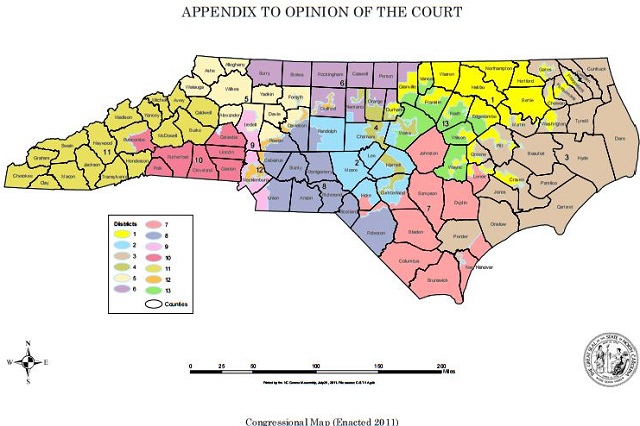 SCOTUS decided Cooper v. Harris today – a case involving voting rights in North Carolina.
SCOTUS decided Cooper v. Harris today – a case involving voting rights in North Carolina.
Here are the basics on the underlying case:
The North Carolina legislature has kept on keepin’ on with its seemingly constant attempts to disenfranchise minority voters as much as is humanly possible. Cooper v. Harris deals with two voting districts – District 1 and District 12 – both of which have been drawn and redrawn according to whatever tactic du jour North Carolina appears to believe will best keep white Republicans in office. District 1 is in the northeastern part of the State, and stretches into Durham, while District 12 begins in the south-central part of the State, takes in Charlotte, and then snakes up to the northern border. And as Justice Elena Kagan noted in today’s opinion with a kind of judicial smirk, “[b]oth have quite the history before this Court.”
North Carolina has historically done whatever it can to create bizarrely-shaped voting districts for the primary purpose of grouping black voters together. That way, instead of black voters making up a functional part of the state’s overall electorate, North Carolina can simply pool them all together in some modern version of Jim Crow Goes To the Polls.
Check out the voting district map here, as referenced in the Court’s opinion:

Weird, right?
North Carolina advanced a totally unconvincing argument about how it wasn’t really being racist, and how the Voting Rights Act made them do it. People have been moving around the state; now that the 2010 census data is in, North Carolina had no choice but to create voting districts that crawl all around a bunch of counties in shapes that would only make sense if you superimposed a corresponding map of where the people of color live.
The Supreme Court ruled 5-3 that the redistricting of Districts 1 and 12 had to go. And the justices weren’t shy about calling one another out today.
The Majority Opinion, written by Justice Kagan, and joined by Justices Ginsburg, Breyer, Sotomayor, and Thomas (I know, right?) essentially said the following:
Sigh. You guys know that doing stuff to purposely dilute the black vote is a bad idea. We’ve been over this. When the legislature does things that treat blacks and whites differently, it only works if it passes strict scrutiny – and nothing passes strict scrutiny [I mean except for Korematsu, but that’s a whole ‘nother matter, and I haven’t had my coffee yet]. There’s no way in hell we are approving a race-based gerrymander. I realize things in government are nuts lately, but we’re not going to back to ye olde days of segregation if SCOTUS has anything to do about it.
The dissent was written by Justice Samuel Alito, and joined by Roberts and Kennedy. Gorsuch was still benched (so to speak) for this one.
Justice Alito (amid foot-stamping and while using the dullest possible simile to tout stare decisis), wrote:
“A precedent of this Court should not be treated like a disposable household item—say, a paper plate or napkin— to be used once and then tossed in the trash.”
Alito went on to say that the newly-drawn districts couldn’t have been wrong, because the plaintiffs in the lawsuit hadn’t suggested any alternative shape. Most of the dissent was an homage to stare decisis with a side of states’ rights. The dissent climaxed with Justice Alito’s argument that North Carolina wasn’t trying to keep blacks down – it was just trying to keep Democrats down.” Before you get all “wait, is that even legal,” I offer you Justice Alito’s explanation:
“Partisan gerrymandering dates back to the founding, and while some might find it distasteful, ‘[o]ur prior decisions have made clear that a jurisdiction may engage in constitutional political gerrymandering, even if it so happens that the most loyal Democrats happen to be black Democrats and even if the State were conscious of that fact.’”
So there you have it.
While dissenting that the Court should have considered North Carolina’s position (that it wasn’t really being racist, but rather, just politically expedient), Justice Alito wielded a clever Shakespearean insult at the majority and called its analysis so one-sided as to be like “Hamlet without the prince.”
Justice Kagan made sure to throw some shade right back in a footnote, which essentially said, “Oh and we’ve read the dissent’s witty [read, totally outdated and boring] Hamlet reference, and it kind of sucks. Instead, check out Inherit the Wind. That one is about an actual court case and addresses the perils of jurists who are deliberately obtuse.”
For some unexpected fun, the staunchly conservative Justice Clarence Thomas went on record to make a point about black Americans that doesn’t involve bootstraps or Booker T. Washington. Justice Thomas concurred in the majority’s decision, not (as is often the case with concurrences) to reach the same decision by an alternate logical road, but rather, to underscore just how right he thought the majority’s analysis was. Thomas’ three-paragraph concurrence raised nothing new, but patted the majority on its collective back for correctly applying past precedent, the Voting Rights Act, and strict scrutiny. Thomas also took some ink to remind everyone that he’s not new to recognizing the problems with North Carolina’s redistricting, and that he said the same thing back in 2001 in another case involving the same issue.
The Court’s decision today was good news for all lovers of democracy and common sense, and bad news for North Carolina Republicans, who will now have to acknowledge that the Three-Fifths Compromise is really, really not going to work anymore.
This is an opinion piece. The views expressed in this article are those of just the author.